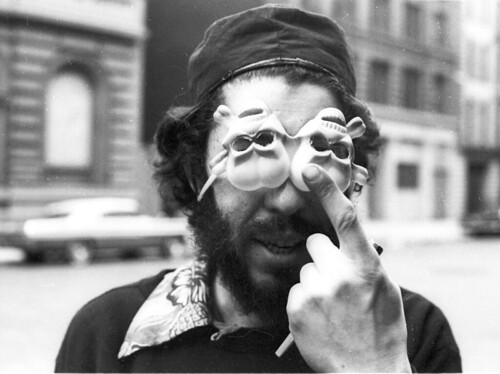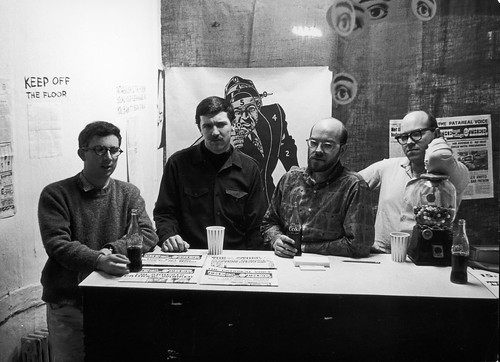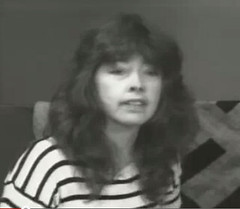 Ralph Ginsburg Coca Crystal
Ralph Ginsburg Coca CrystalThe first thing on Jackie Diamond’s to-do list: “2008 – Publish book.”
“You see I’m behind schedule,” the 64-year-old said of the unfinished work, her chest purring with laughter. “I got busy with cancer.”
Ms. Diamond is better known to students of the underground as Coca Crystal – a secretary, writer, and “Slum Goddess” for The East Village Other who went on to host a cult cable-access television show for nearly two decades.
In 2006, she was diagnosed with lung cancer. Since then, she’s had three operations to remove over a third of her lungs, undergone chemotherapy, and become a patient at Memorial Sloan-Kettering Cancer Center in Manhattan. The last time her cancer returned, her doctor told her it had spread to a part of her lung that was inoperable.
Her to-do list continues: “2010 – Movie based on my life released. Drew Barrymore stars as Coca Crystal.”
“And then the dignitaries and the party,” Ms. Crystal imagined. “And then I’ll live happily ever after. Finally.”
But the real reason she wants to publish her book isn’t the dream of a movie deal – it’s Gus. Read more…
 Bob Simmons Tuli Kupferberg
Bob Simmons Tuli KupferbergThe funniest part of reminiscing about the uber-subversive East Village Other for The New York Times is that the latter set me on the road to rebellion before the former was even founded in 1965. I’m told I was reading by age four and within a few years the first section I grabbed when the Sunday Times arrived every weekend was the Book Review. The Grove Press ads kidnapped my imagination: Who was this Alain Robbe-Grillet guy and how do you pronounce his name? Why was William Burroughs considered so dangerous and did his characters have meals while wearing no clothes? And speaking of clothes, how come the girls on Grove’s covers wore so little?
Obviously my nascent libido was ready for plucking, but my fascination was not simply sexual. I wanted to know why in the land of the First Amendment some had wanted to ban these books.
I bought my first issue of the Village Voice in February 1966; it contained an obituary of the abstract expressionist Hans Hofmann. Already a Dylan fan, I scanned the ads for folk clubs and was absolutely smitten by bohemia. The first girl who won my heart in elementary school was Jessica Hentoff (I don’t recall my feelings being reciprocated) and her father Nat wrote for the Voice. Soon I picked up the Voice’s competitor, The East Village Other.
No friends’ parents wrote for EVO. Scruffier, funnier and dirtier than the Voice, EVO was not simply about bohemia, it was an anarchist’s bomb in newsprint hurled at the bourgeoisie. Even at my tender age, I knew that I didn’t like the world that grown-ups had created. The troublemakers at The Other were expressing themselves in ways I could only daydream about at that point. Read more…
In Larry “Ratso” Sloman’s 1998 book, “Steal This Dream: Abbie Hoffman and the Counter-Culture Revolution in America,” he recounts what happened the day Abbie Hoffman dragged him and Peter Leggieri out of the East Village Other office to witness the Yippie icon’s attack on Wall Street. Mr. Sloman was a lowly EVO intern at the time who credits the paper with giving him his start as a writer. The excerpt is reprinted here with the author’s permission.
Read more…
Coca Crystal (born Jackie Diamond) was EVO’s self-described “gatekeeper,” receptionist, sometime reporter and sometime model until the bitter end, when, as staff and resources dwindled, she became its defacto publisher (she financed the final two issues out of her own purse). Here, she describes how she got her start.
The first time I set foot in the EVO office, it was in the fall of 1969 and I had come to visit with a college friend, Barbara, who was EVO’s secretary.
The office was located on the third floor of the Fillmore East building on Second Avenue and Sixth Street. The place was a wreck. It was freezing, the garbage cans were overflowing, cigarette butts were everywhere, and the walls were covered in fabulous cartoons by the best in underground comix: R. Crumb, Kim Deitch, Spain Rodriguez, Yossarian, Shelton, Art Spiegelman, just to name a few. It was chaos, but a kind of cool chaos.
The office was in a frenzy to get copy ready for the typesetter, and I was asked if I could type. I said I could and was given the job of typing up the classifieds. I had never seen such weird ads. (“Dominant Iguana seeks submissive zebra,” sex ads, odd employment opportunities, legal advice for pot busts). I had to type while sitting on Allen Katzman’s lap (his idea), wearing my winter coat and gloves. When I had completed the classifieds I was told the other secretary, Marcia, was leaving and I could have her job if I wanted it. The pay was $35 a week. I took the job. Read more…
 Fred W. McDarrah/Getty Images From left: Dan Rattiner, Walter Bowart, and brothers Allen and Don Katzman. Jan. 14, 1966.
Fred W. McDarrah/Getty Images From left: Dan Rattiner, Walter Bowart, and brothers Allen and Don Katzman. Jan. 14, 1966.Little is it known that Dan Rattiner, doyen of Dan’s Papers, helped launch the East Village Other alongside its more celebrated founders, the late Walter Bowart and the late Allen Katzman. In 1964, having abandoned graduate school in architecture at Harvard, Mr. Rattiner, in between gigs producing a summer newspaper in Montauk, rented an apartment in a brownstone on West 10th Street in Greenwich Village. A year later, in the fall of 1965, something amazed him on the newsstand at Eighth Street and Sixth Avenue. He picks up the story from there.
It cost 15 cents and was an enormous piece of newsprint all folded up into tabloid size. The four pages, when unfolded looked more like a work of modern art than a newspaper. A new way to print a newspaper was on the market. It involved using scissors and rubber cement to put together a proof of a page, then making a plate from a photograph of it and then printing from that. But I had never seen anyone make use of the new process like this before; most people just used it to mimic the old.
As for the content, it was also revolutionary. The lead headline read: “TO COMMEMORATE THE GLORIOUS NEWSPAPER STRIKE THE HERETOFORE UNDERGROUND ‘OTHER’ EXPANDS ITS PATAREALISM.” In huge black type, the words coiled along the perimeter of the page and ended with a half-tone photograph of a half-closed eye. “Peace Rally Breeds Strange Bedfellows,” was the headline below. “Generation of Draft Dodgers” read another headline below that.
I bought it. And I looked for, and found the name, address and phone number of the publisher and editor, Walter Bowart. Read more…
 Jesse FishThe Yippie movement started in the basement of this building at 30 St. Marks Place.
Jesse FishThe Yippie movement started in the basement of this building at 30 St. Marks Place.“New York is naturally fantastic — especially where I live — just one gigantic happening,” wrote the young 1960’s political activist, Abbie Hoffman, while living on Avenue C and 11th Street. Hoffman, the counterculture, anti-war advocate had recently arrived in the city divorced, jobless and estranged from his family in Worcester, Mass. Feeling free and ambitious, Hoffman promptly set out to organize political and spiritual movements which he believed would change the warring Western world.
Hoffman, along with Jerry Rubin, went on to establish the Yippie — short for Youth International Party — political group while residing in a basement apartment at 30 St. Marks Place, until recently home to the Japanese restaurant Go. In Hoffman’s mind, the Yippies would be an answer to the hippie movement, which he believed was aimless and too drug-centered to accomplish any real change in United States policy.
Hoffman once affirmed that a “Yippie is a hippie who’s been beaten up by the cops,” and thought that the neighborhood was the perfect launching pad for his alternative faction. Abbie spoke of the East Village as “the real hip underground, the successor to Greenwich Village as the heartland of bohemianism.”
Read more…









